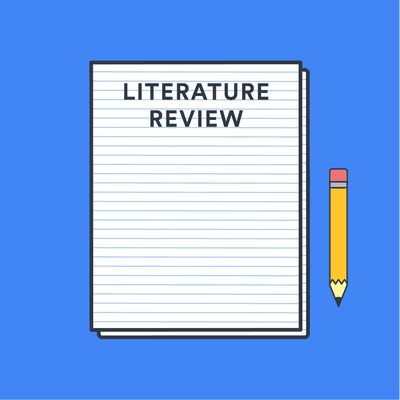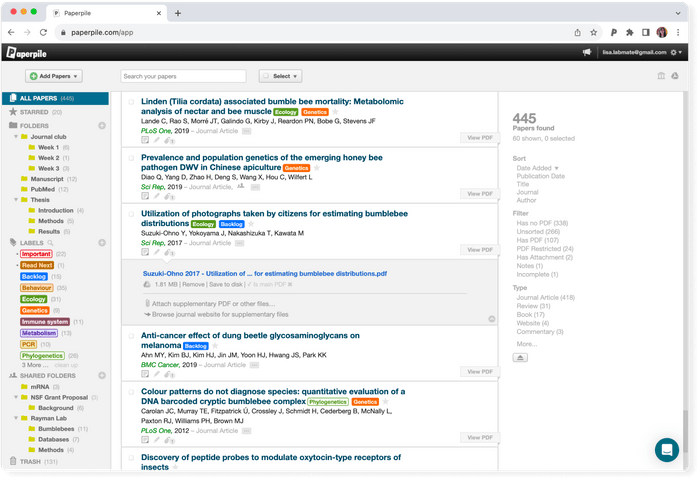How to write a literature review in 6 steps

What is a literature review?
A literature review is an assessment of the sources in a chosen topic of research.
A good literature review does not just summarize sources. It analyzes the state of the field on a given topic and creates a scholarly foundation for you to make your own intervention. It demonstrates to your readers how your research fits within a larger field of study.
In a thesis, a literature review is part of the introduction, but it can also be a separate section. In research papers, a literature review may have its own section or it may be integrated into the introduction, depending on the field.
➡️ Our guide on what is a literature review covers additional basics about literature reviews.
- Identify the main purpose of the literature review.
- Do extensive research.
- Evaluate and select relevant sources.
- Analyze the sources.
- Plan a structure.
- Write the review.
How to write a literature review
In this section, we review each step of the process of creating a literature review.
1. Determine the purpose of your literature review
In the first step, make sure you know specifically what the assignment is and what form your literature review should take. Read your assignment carefully and seek clarification from your professor or instructor if needed. You should be able to answer the following questions:
- How many sources do I need to include?
- What types of sources should I review?
- Should I evaluate the sources?
- Should I summarize, synthesize or critique sources?
- Do I need to provide any definitions or background information?
In addition to that, be aware that the narrower your topic, the easier it will be to limit the number of sources you need to read in order to get a good overview of the topic.
2. Do an extensive search
Now you need to find out what has been written on the topic and search for literature related to your research topic. Make sure to select appropriate source material, which means using academic or scholarly sources, including books, reports, journal articles, government documents and web resources.
➡️ If you’re unsure about how to tell if a source is scholarly, take a look at our guide on how to identify a scholarly source.
Come up with a list of relevant keywords and then start your search with your institution's library catalog, and extend it to other useful databases and academic search engines like:
➡️ Our guide on how to collect data for your thesis might be helpful at this stage of your research as well as the top list of academic search engines.
3. Evaluate and select literature
Once you find a useful article, check out the reference list. It should provide you with even more relevant sources. Also, keep a note of the:
- title
- date
- authors' names
- page numbers
- publisher
Keeping track of the bibliographic information for each source will save you time when you’re ready to create citations. You could also use a reference manager like Paperpile to automatically save, manage, and cite your references.

Read the literature. You will most likely not be able to read absolutely everything that is out there on the topic. Therefore, read the abstract first to determine whether the rest of the source is worth your time. If the source is relevant for your topic:
- Read it critically.
- Look for the main arguments.
- Take notes as you read.
- Organize your notes using a table, mind map, or other technique.
4. Analyze the literature
Now you are ready to analyze the literature you have gathered. While your are working on your analysis, you should ask the following questions:
- What are the key terms, concepts and problems addressed by the author?
- How is this source relevant for my specific topic?
- How is the article structured? What are the major trends and findings?
- What are the conclusions of the study?
- How are the results presented? Is the source credible?
- When comparing different sources, how do they relate to each other? What are the similarities, what are the differences?
- Does the study help me understand the topic better?
- Are there any gaps in the research that need to be filled? How can I further my research as a result of the review?
5. Plan the structure of your literature review
There are various ways to organize your literature review:
- Chronological method: Writing in the chronological method means you are presenting the materials according to when they were published. Follow this approach only if a clear path of research can be identified.
- Thematic review: A thematic review of literature is organized around a topic or issue, rather than the progression of time.
- Publication-based: You can order your sources by publication, if the way you present the order of your sources demonstrates a more important trend. This is the case when a progression revealed from study to study and the practices of researchers have changed and adapted due to the new revelations.
- Methodological approach: A methodological approach focuses on the methods used by the researcher. If you have used sources from different disciplines that use a variety of research methods, you might want to compare the results in light of the different methods and discuss how the topic has been approached from different sides.
6. Write your literature review
Regardless of the structure you chose, a review should always include the following three sections:
- An introduction, which should give the reader an outline of why you are writing the review and explain the relevance of the topic.
- A body, which divides your literature review into different sections. Write in well-structured paragraphs, use transitions and topic sentences and critically analyze each source for how it contributes to the themes you are researching.
- A conclusion, which summarizes the key findings, the main agreements and disagreements in the literature, your overall perspective, and any gaps or areas for further research.
➡️ If your literature review is part of a longer paper, visit our guide on what is a research paper for additional tips.
Other resources to help you write a successful literature review
Frequently Asked Questions about writing a literature review
🎯 What is the goal of a literature review?
The goal of a literature review is to asses the state of the field on a given topic in preparation for making an intervention.
🧗 In what section of my paper should I add a literature review?
A literature review should have its own independent section. You should indicate clearly in the table of contents where it can be found, and address this section as “Literature Review.”
🏃🏿♂️ What is the average length of a literature review?
There is no set amount of words for a literature review; the length depends on the research. If you are working with a large amount of sources, then it will be long. If your paper does not depend entirely on references, then it will be short.
🐾 Do I have to include a literature review in my paper?
Most research papers include a literature review. By assessing the available sources in your field of research, you will be able to make a more confident argument about the topic.
🥨 What type of papers include literature reviews?
Literature reviews are most commonly found in theses and dissertations. However, you find them in research papers as well.


